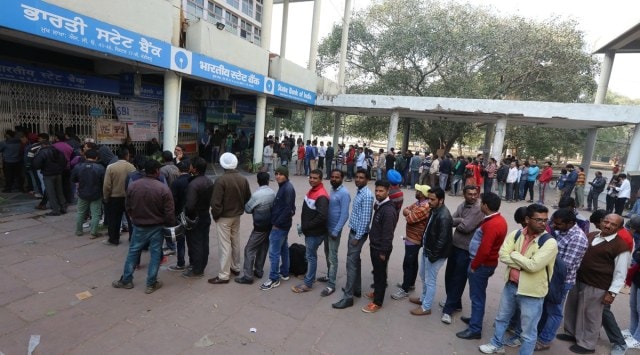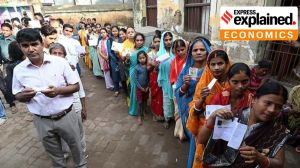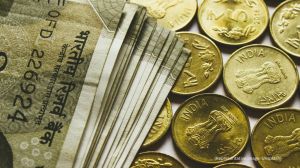Stay updated with the latest - Click here to follow us on Instagram
Six years after demonetisation: A look at what happened and changed
Prime Minister Narendra Modi, in his televised address to the nation on November 8, 2016, said that the two banknotes will be "just worthless piece of paper," with immediate effect.
 People form a long queue outside an ATM in Bank Square, Sector 17 of Chandigarh, to withdraw money on December 10, 2016, a month after Indian government announced the demonetisation of banknotes of Rs 500 and Rs 1000. (Express Photo by Kamleshwar Singh)
People form a long queue outside an ATM in Bank Square, Sector 17 of Chandigarh, to withdraw money on December 10, 2016, a month after Indian government announced the demonetisation of banknotes of Rs 500 and Rs 1000. (Express Photo by Kamleshwar Singh)Six years ago, on this day, November 8, the Government of India announced the demonetisation of all banknotes of Rs 500 and Rs 1,000, as a step against accumulation and circulation of domestic black money.
Prime Minister Narendra Modi, in his televised address to the nation on November 8, 2016, said that the two banknotes will be “just worthless piece of paper,” with immediate effect, and went on to introduce new notes of Rs 2,000 and Rs 500 for public circulation.
While many have pegged it as a “bold” move, the Opposition, over the years, has criticised the BJP government, calling the decision a “failure”.
 People standing to exchange their old currencies in front of Reserve Bank of India building, New Delhi in March, 2017. (Express photo by Prem Nath Pandey).
People standing to exchange their old currencies in front of Reserve Bank of India building, New Delhi in March, 2017. (Express photo by Prem Nath Pandey).
Six years later, Congress leader Rahul Gandhi, in a tweet on Monday, attacked the move implemented by the BJP-led government in the country. He wrote, “In demonetisation, the ‘Raja’ did the DeMo-lition of the economy with the promise of ’50 days’.”
भाजपा शासन में काला धन वापस आया और गरीबी तेज़ी से कम हुई।
अर्थव्यवस्था मजबूत हुई, भारत विश्व की पाँचवी सबसे बड़ी अर्थव्यवस्था बना।
करोड़ों छोटे व्यापार और रोज़गार आगे बढे।
इस demonetisation से काले धन पे जो वार हुआ उससे आपको नाराज़गी है, हम समझ सकते हैं। दर्द साफ़ झलक रहा है। https://t.co/11Cv9eHgKs pic.twitter.com/Ye8OlWBfqu
— Amit Malviya (@amitmalviya) November 7, 2022
Replying to Gandhi, Amit Malviya, the in-charge of BJP’s IT Cell, wrote, “We can understand that you are angry with the attack on black money due to this demonetisation. The pain is clearly visible.”
Malviya also shared two graphics which highlighted the gains due to demonetisation. The posters stated, “undisclosed assets worth Rs 7,877 crore seized,” and undisclosed income worth “Rs 87, 200” admitted. The move continues to be upheld by several Ministers in the Government.
Demonetisation: A digital push?
Union Finance Minister Nirmala Sitharaman had hailed the move as a “major push to digital economy” in 2020.
As India went into stringent lockdowns during the Covid-19 pandemic-hit years – 2020 and 2021 – people, however, started accumulating cash to meet their essential needs. Although currency with the public, which stood at Rs 17.97 lakh crore on November 4, 2016, declined to Rs 7.8 lakh crore in January 2017 soon after demonetisation, cash in system recorded a steady increase in the year 2020. In the fortnight ended October 23, 2020, the currency with public rose by Rs 10,441 crore.
 A worker fixes a board displaying the suffering related to demonetisation and other tax reforms by the central govt prior to a protest by Congress party at Azad Maidan, in Mumbai, on the first anniversary day of demonetisation, 2017. (Express Photo by Nirmal Harindran)
A worker fixes a board displaying the suffering related to demonetisation and other tax reforms by the central govt prior to a protest by Congress party at Azad Maidan, in Mumbai, on the first anniversary day of demonetisation, 2017. (Express Photo by Nirmal Harindran)
As of October 8, 2021, currency with the public stood at Rs 28.30 lakh crore. Moreover, as The Indian Express has reported, currency in circulation (CIC) increased to a high of 14.4 per cent of GDP in 2020-21, a jump from 10.7 per cent of GDP in 2017-18.
 Youth Congress activists raise slogans during protest outside Reserve Bank Of India branch (RBI) after two years of demonetisation, in Shimla, in 2018. (Express Photo by Pradeep Kumar)
Youth Congress activists raise slogans during protest outside Reserve Bank Of India branch (RBI) after two years of demonetisation, in Shimla, in 2018. (Express Photo by Pradeep Kumar)
Opposition leaders slammed the demonetisation move citing the report, which states that cash with public recorded a new high of Rs 30.88 lakh crore at the fortnight ended October 21, 2022. Congress President Mallikarjun Kharge said, “6 years after the ‘masterstroke’ the cash available in public is 72% higher than that in 2016. PM is yet to acknowledge this epic failure that led to fall of economy.”
Even though the RBI and the government bodies push for a “less cash society,” the report highlights that cash continues to dominate the market as the preferred mode of payment. Despite multiple digital payment methods available to the public, businesses depend on cash for end-to-end transactions. Cash continues to remain the reliant mode of transaction for 15 crore people who do not have access to a bank account.
Protests by the Opposition
These six years have seen various protests organized by leaders of the Opposition parties against the “harm” the move had caused to the country’s economy.
The sudden withdrawal of notes resulted in liquidity shortage in 2016, with long queues outside banks. About 115 people reportedly died while standing in queues to withdraw money from their bank accounts. The circulation of the new Rs 500 and Rs 2000 banknotes was, moreover, reported to be slow.
 Congress party workers protest on the 2nd anniversary of demonetisation at CSTM in Mumbai, in 2018. (Express Photo by Prashant Nadkar).
Congress party workers protest on the 2nd anniversary of demonetisation at CSTM in Mumbai, in 2018. (Express Photo by Prashant Nadkar).
It had roiled the economy, with demand falling, businesses facing a crisis, and GDP growth declining close to 1.5 per cent. Many small units were hit hard, with many reporting huge losses even after nine months.
Days after the announcement made by PM Modi in 2016, Left parties called for a 12-hour bandh in the country’s capital. The AAP and Congress also held separate rallies and marches against the move.
A year down the line, in 2017, the Gujarat Jan Andolan, led by Nirjhari Sinha, decided to clank belans (rolling pins) on steel plates at the Sardar Baug in Laldarwaja, Ahmedabad, to register their protest against the demonetisation drive.
 Student wing NSUI protest with frying snacks to mark the fourth year anniversary of demonetisation, in New Delhi on Sunday, 8th November, 2020. (Express photo by Abhinav Saha)
Student wing NSUI protest with frying snacks to mark the fourth year anniversary of demonetisation, in New Delhi on Sunday, 8th November, 2020. (Express photo by Abhinav Saha)
In 2018, the Indian Youth Congress organised a protest outside RBI Headquarters, while Opposition leaders and bodies attacked PM Modi-led NDA government for “ruining” and “wrecking” the country’s economy. The Congress party had also declared to hold protests across the country and seek an apology from Prime Minister Narendra Modi for the same.
 Student wing NSUI performed the last rites of Indian economy to mark the fourth year anniversary of demonetisation, in New Delhi on Sunday, 8th November, 2020. (Express photo by Abhinav Saha)
Student wing NSUI performed the last rites of Indian economy to mark the fourth year anniversary of demonetisation, in New Delhi on Sunday, 8th November, 2020. (Express photo by Abhinav Saha)
The year 2019 also saw agitations by the Gujarat Pradesh Congress Committee at taluka, district and state levels across Gujarat from November 8 to 15 against BJP, economic slowdown, unemployment, and banking sector crisis around the country.







